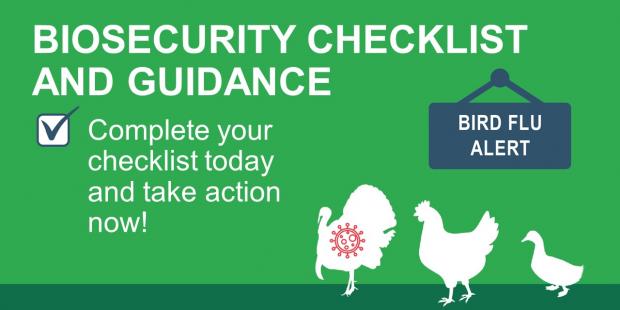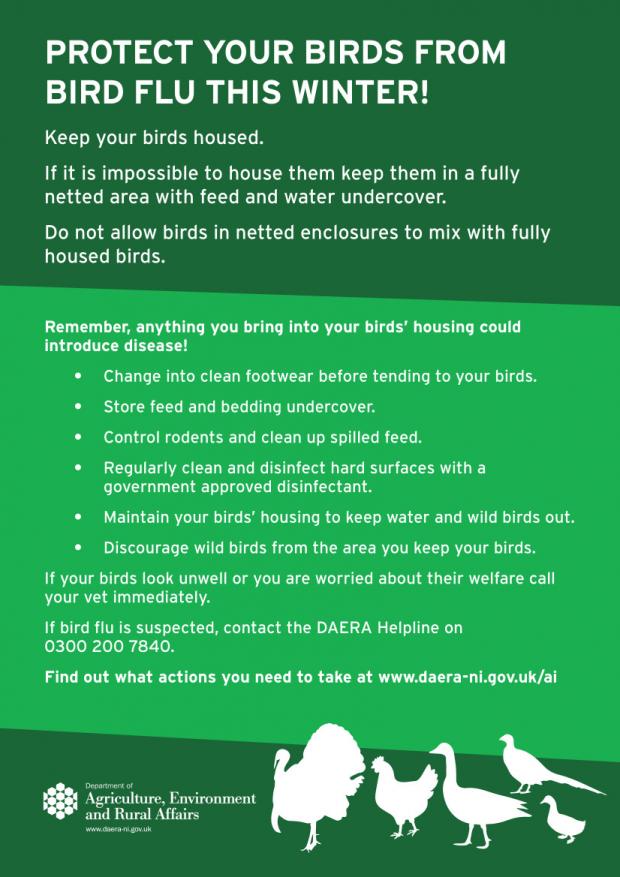
Biosecurity Checklist
Excellent biosecurity remains the best defence for reducing the risk of transmission of avian influenza to poultry or other captive birds. A self-assessment tool to aid flock keepers in the review of their biosecurity arrangements and provide the necessary assurances is available here. DAERA encourages anyone who keeps birds from one bird upwards to consider this checklist to protect your birds, the poultry industry and our economy over this higher risk period. The checklist can be completed online and saved to your device.
To assist with maintaining optimum biosecurity at your premises, DAERA has developed an Avian Influenza Biosecurity Checklist in conjunction with the British Poultry Council. Please ensure that you can tick every box on this checklist where appropriate.
Biosecurity guidance
The best defence – as with all exotic animal diseases – is a high level of awareness and good biosecurity. Poultry keepers and businesses in Northern Ireland are reminded of the importance of maintaining biosecurity in their flocks and being vigilant to any signs of disease in their birds.
We have published a biosecurity leaflet for all bird keepers and detailed guidance on biosecurity and preventing welfare impacts in poultry and captive birds.
We have also published a biosecurity leaflet providing additional guidance for bird keepers visiting public places such as parks and wild waterfowl sites in order to reduce the risk of spreading disease to their birds.
If you suspect any strain of avian flu you must tell your local Divisional Veterinary Office immediately. Failure to do so can be deemed an offence.
Further information on biosecurity and good practice is available via the links below:
- Biosecurity self-assessment tool Nov 2020
- Biosecurity and housing requirements for chicken and turkey keepers
- Biosecurity and housing requirements for ducks, geese and game birds
- Help prevent Avian Influenza - biosecurity information leaflet
- Biosecurity and preventing welfare impacts in poultry and captive birds
- Guidance on Avian Influenza for hunters
- Avian Influenza labelling guidance
- Poultry keepers must continue to follow the existing animal welfare rules
- Guidance for Farm Biosecurity and Vehicle Disinfection for deliveries
- Protect your birds from bird flu this winter guidance poster:

Risk Level
Following the increase in cases across these islands, the risk of a HPAI incursion to domestic poultry in Northern Ireland has been reviewed and is now assessed as moderate with biosecurity continuing to play a key role in the potential to reduce the risk posed to each individual flock.
The VRA highlighted that it was imperative the poultry industry should reinforce their biosecurity arrangements including the physical separation of wild birds, particularly water fowl and gulls, from poultry and captive birds.
The Chief Vets from England, Scotland, Wales and Northern Ireland are urging bird keepers across the UK to maintain and strengthen their biosecurity measures in order to prevent further outbreaks of avian influenza in the UK.
If you keep poultry or captive birds, please follow our Biosecurity Guidance and use our Biosecurity Checklist
If you keep poultry (including game birds or as pets) please remain vigilant for any signs of disease in your flock and if you have any concerns about the health of your birds please report it to the DAERA Helpline on 0300 200 7840 or to your local DAERA Direct Regional Office.
Vaccination
The vaccination of poultry and most captive birds against avian influenza is not currently permitted. Vaccination is not a routine control measure and is a practice restricted by legislation.
What signs should I look out for?
There are 2 types of avian influenza.
Highly Pathogenic avian influenza (HPAI) and Low Pathogenic avian influenza (LPAI).
Highly pathogenic avian influenza is the more serious type. The main clinical signs of HPAI in birds are:
- Swollen head
- Blue discoloration of neck and throat
- Loss of appetite
- Respiratory distress, such as gaping beak, coughing, sneezing, gurgling, rattling
- Diarrhoea
- Fewer eggs laid
- Increased mortality
- Nervous signs
- Dullness
Clinical signs can vary between species of bird and some species, for example, ducks and geese, may show minimal clinical signs. Birds may often die without any signs of disease being apparent. However, there can be considerable variation in the clinical signs and severity of the disease.
Avian Influenza is a notifiable disease. If you suspect that your birds have Avian Influenza, by law you must report it. You should contact your Private Veterinary Practitioner (PVP) or local DVO immediately so that it can be investigated.
See some photos of clinical signs of avian influenza on Flickr.
How avian influenza is spread
Avian influenza is not an airborne virus. It spreads from bird to bird by direct contact or through contaminated body fluids and faeces. It can also be spread by contaminated feed and water or by dirty vehicles, clothing and footwear.
There is no evidence that any recent strain of avian influenza has been able to spread directly between people.
It is very important to ensure that any outbreak of AI is controlled quickly and that workers and veterinarians in close contact with infected birds are well protected. The Department of Agriculture, Environment and Rural Affairs (DAERA) has a contingency plan in place to ensure that this is so.
The Notifiable Epizootic Avian Disease Control Strategy describes how an outbreak of Avian Influenza or Newcastle Disease in Northern Ireland would be managed. Further information can be found at link below.
Domestic poultry
The European Commission requires all Member States of the European Union to undertake surveys each year for avian influenza in poultry. As a result of the Withdrawal Agreement and Northern Ireland Protocol, this is still a requirement for Northern Ireland.
The purpose of this survey is to detect avian influenza (AI) virus infections of subtypes H5 and H7 in different species of poultry and provides valuable information across the EU for an early warning system of H5 and H7 AI infections. Early detection is also essential for effective control.
The flocks that are chosen for sampling are drawn from poultry premises selected at random. The survey includes chickens, turkeys, ducks, geese and feathered game classified as poultry. In Northern Ireland, premises are contacted in advance by DAERA staff to arrange a convenient time for sampling. Blood samples are taken from a number of birds on each premises. The samples are then screened for the presence of antibodies to avian influenza viruses of subtypes H5 and H7.
